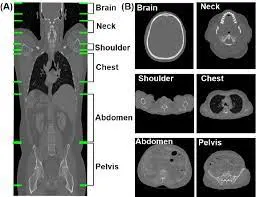如何解读全身CT扫描:3种基本方法
介绍
解读全身CT扫描对于诊断和管理各种疾病至关重要。本指南旨在帮助临床医生和学生理解全身CT扫描解读的基本知识。通过关注详细的解剖结构和常见发现,它揭开了这一成像技术的复杂性。无论您是经验丰富的放射科医生还是初入该领域,本指南的结构化方法确保您对这一重要诊断工具有全面的了解。
探索全身CT扫描:成像技术的详细指南
全身CT扫描提供了整个身体的广泛视图,有助于诊断和管理各种疾病。本节解释了什么是全身CT扫描及其在临床实践中的关键作用。通过理解这些扫描的独特特性,医疗专业人员可以在各种临床情况下作出明智的决策,从创伤评估到癌症分期。
全身CT成像:了解不同技术
全身CT扫描提供全面的成像解决方案,对于评估整个身体复杂的解剖结构至关重要。
- 高清成像: 这些扫描提供详细的图像,对于识别细微解剖细节和异常至关重要。
- 3D重建: 提供身体结构的三维视图,提高对空间关系和病理的理解。

全身CT扫描的适应症:何时及为何必要
全身CT扫描在特定临床场景中是不可或缺的诊断工具:
- 创伤评估: 用于评估严重创伤后的损伤,CT扫描提供整个身体的详细视图。
- 癌症分期: 对于检测转移和规划治疗至关重要,提供身体内部结构的全面视图。
- 慢性病管理: 对于监测系统性疾病等情况至关重要,并指导长期治疗计划。
理解全身CT扫描何时及为何必要是有效患者管理的关键。
解读全身CT扫描的专家技术
全身CT扫描的解读涉及特定的技术和工具,具体如下:
1. 使用X-ray Interpreter的AI辅助分析
X-ray Interpreter结合了先进的AI技术,能够准确、迅速地解读全身CT扫描图像。这种方法用户友好,快速提供可靠的结果。
AI辅助全身CT扫描解读的步骤:
- 注册: 在 X-ray Interpreter 上注册,以使用AI分析功能。
- 上传CT扫描: 将您的全身CT扫描图像上传至平台。
- 审查解读: 检查AI生成的解读,并下载详细报告。
- 咨询: 如有需要,与医疗专业人员讨论AI解读以获取临床见解。
请访问我们的 入门指南。
2. 使用ChatGPT Plus的互动分析
ChatGPT Plus利用GPT-4V模型提供全身CT扫描的互动和详细分析。这种方法允许与AI进行动态互动,根据特定需求进行个性化分析:
- 订阅: 通过订阅ChatGPT Plus访问GPT-4V。
- 上传CT扫描: 使用OpenAI平台上传全身CT扫描图像。
- 请求分析: 通过对话询问AI分析图像。
- 审查与咨询: 检查AI的发现,并根据需要请求进一步的澄清或细节。
有关更多详细信息,请阅读 我们的文章。
或者,随着其他具有视觉能力的AI模型的不断涌现,您也可以尝试其他模型,例如 xAI 的 Grok, Anthropic 的 Claude,以及 Google Deepmind 的 Gemini。
3. 传统自我解读
传统的自我解读依赖放射科医生的专业知识来解读全身CT扫描。这种传统方法需要大量的经验和持续的教育:
- 教育: 从认证课程或机构获得全身CT扫描解读的基础知识和培训。
- 实践: 在经验丰富的放射科医生的指导下,定期练习解读扫描。
- 资源: 通过专业文献和专注于全身成像的教育工具来提升技能。
- 反馈与学习: 通过寻求同事反馈和参与专业发展活动不断改进。
自我解读的推荐资源:
-
- AQMDI提供的这本指南对CT扫描解读进行了详细概述,涵盖关键解剖结构和常见发现。
-
- 这篇wikiHow文章提供了阅读CT扫描的逐步说明,使初学者和专业人士均可轻松理解。
-
- Radiopaedia的文章概述了全身CT扫描的协议,包括适应症、目的和技术,对于创伤和其他重要评估至关重要。
全身CT扫描解读方法的比较评审
选择适当的全身CT扫描解读方法影响诊断准确性和患者管理。本节根据准确性、易用性和教育价值等标准比较三种主要技术——AI辅助分析、使用ChatGPT Plus的互动分析和传统自我解读。
| 标准 | X-ray Interpreter | ChatGPT Plus | 自我解读 |
|---|---|---|---|
| 准确性 | 大多高(基于AI)1 | 大多高(基于AI)1 | 不同(依赖技能) |
| 易用性 | 简单 | 中等 | 困难 |
| 成本 | 每张图像起价$2.50 | 每月$20 | 免费(不包括教育费用) |
| 时间效率 | 快 | 中等至快 | 慢至中等 |
| 学习曲线 | 低 | 低至中等 | 高 |
| 额外资源 | 提供 | 部分提供(通过OpenAI) | 自行搜集 |
结论:提升全身影像诊断技能
有效解读全身CT扫描对于准确诊断各种疾病至关重要。本指南强调了解读这些扫描的三种方法,每种方法适合不同的专业水平和要求。随着医学影像领域的不断发展,及时了解最新的解读技术对提供最佳患者护理至关重要。
相关文章
额外资源和学习机会
为了进一步探索全身CT扫描解读,提供了各种资源:
-
全身CT扫描:您需要知道的: 这本FDA的详细指南解释了全身CT扫描,包括潜在风险、益处以及将CT扫描作为预防措施使用的局限性。
-
全身CT扫描 - 维基百科: 维基百科文章提供了全身CT扫描的综合概述,讨论其用途、益处以及与其在无症状个体应用相关的争议。
-
关于全身扫描的真相: 这篇WebMD文章探讨了全身扫描的利弊,包括其在早期疾病检测中的有效性和可能导致的不必要治疗的假阳性。